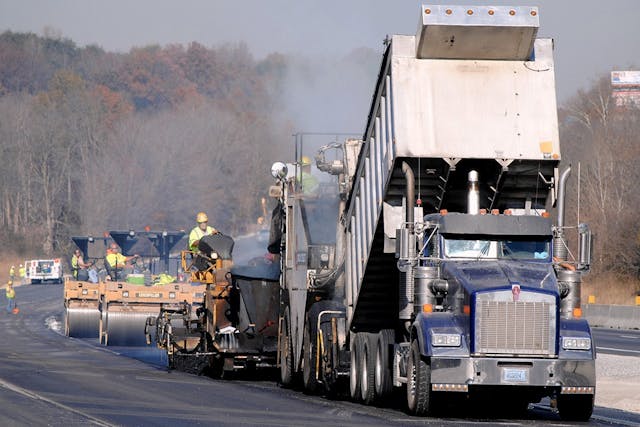Hot Mix Asphalt Paving: Redefining Industrial Residential Or Commercial Property Landscapes
Hot Mix Asphalt Paving: Redefining Industrial Residential Or Commercial Property Landscapes
Blog Article
Opening the Keys of Warm Mix Asphalt Innovation
Discovering the midsts of warm mix asphalt technology reveals a world where precise solutions and careful processes assemble to form our roadways and facilities. The fusion of accumulations, fillers, and binders isn't just a building and construction task however a tactical orchestration of longevity and performance.
Relevance of Warm Mix Asphalt
Warm Mix Asphalt plays an important function in modern-day framework advancement as a result of its sturdiness and cost-effectiveness. As the most commonly made use of paving product for roadways, highways, and car park, Warm Mix Asphalt supplies a series of benefits that add to its significance in construction jobs. One vital advantage is its capability to hold up against heavy web traffic lots and extreme climate problems, offering a durable and trusted surface area for transportation networks. Furthermore, Warm Mix Asphalt is economical in both first construction and long-term maintenance, making it a preferred option for numerous facilities projects.
The sturdiness of Hot Mix Asphalt stems from its make-up, which includes accumulations, binder, and filler products that are thoroughly picked and mixed to satisfy specific efficiency demands. This specific mix causes a flexible and solid sidewalk that can withstand frequent use without considerable deterioration. Warm Mix Asphalt is 100% recyclable, further boosting its sustainability and ecological benefits. Overall, the value of Hot Mix Asphalt in framework advancement can not be understated, as it remains to be a foundation of modern-day building practices.
Components of Asphalt Mixes
The composition of asphalt blends contains meticulously selected aggregates, binder, and filler materials that are crucial for achieving specific performance requirements. Accumulations are the primary component of asphalt blends, offering toughness and stability. These aggregates can be natural, such as gravel or crushed rock, or artificial, like recycled products from old pavements. The binder, usually asphalt or asphalt concrete, holds the accumulations together and offers adaptability and toughness to the mix. The selection of the binder is important as it straight influences the mix's efficiency in various climate condition. Fillers, such as moisturized lime or Portland cement, are made use of to improve the mix's workability and aging resistance. Angled Parking.
The mix and proportion of these elements play a substantial role in establishing the top quality and efficiency of the asphalt mix. Engineers meticulously develop the mix to fulfill particular needs, considering factors like traffic volume, environment conditions, and pavement life expectancy. Appropriate selection and harmonizing of accumulations, binder, and fillers are important for creating sturdy, resilient asphalt pavements.
Combining and Manufacturing Techniques

Once the aggregates are chosen, the binder, frequently asphalt concrete, is added to bind the products together. The binder's quality and quantity substantially influence the mix's stamina, flexibility, and resistance to ecological elements. Additionally, fillers like moisturized lime or Rose city cement may be incorporated to improve specific qualities of the asphalt mix, such as its workability or wetness resistance.
During manufacturing, the accumulations and binder are heated, normally in between 250-325 ° F(121-163 ° C ), to promote blending and ensure proper finishing of the accumulations. The mixing process needs to be extensive to attain a homogeneous combination that promotes the preferred performance characteristics of the asphalt. Various methods, such as batch my response mixing or drum mixing, are employed to attain regular and high-quality asphalt mixes for building and construction projects.
Elements Influencing Asphalt Efficiency
Elements influencing asphalt efficiency incorporate an array of variables that affect the sturdiness, durability, and general high quality of asphalt pavements. One essential aspect is the quality of products utilized in the asphalt mix.

Environmental problems likewise affect asphalt performance. Temperature level variants, wetness infiltration, and website traffic lots can all affect the architectural honesty of the sidewalk. Layout considerations, such as sidewalk thickness and drain, are crucial in ensuring the lasting performance of the asphalt pavement. By thoroughly taking into consideration these specialists, factors and engineers can maximize asphalt efficiency and boost the solution life of sidewalks.
Lasting Practices in Asphalt Innovation

WMA enables for the manufacturing and placement of asphalt blends at reduced temperatures contrasted to conventional hot-mix asphalt, resulting in minimized energy consumption and greenhouse gas discharges. The use of porous asphalt mixes can help mitigate stormwater drainage these details issues by permitting water to infiltrate with the pavement and right into the ground, promoting natural water filtering and recharge processes.
Verdict
Finally, warm mix asphalt technology plays an essential role in modern-day framework development because of its sturdiness and cost-effectiveness. By meticulously balancing elements, using proper blending techniques, and taking into consideration various factors, designers can develop high-grade asphalt mixes that endure rush hour loads and rough climate condition. Accepting sustainable techniques, such as using recycled materials and warm-mix modern technologies, even more improves the environmental friendliness of asphalt modern technology.
Mixing and production strategies in warm mix asphalt technology include the exact mix pop over to these guys and handling of aggregates, binder, and fillers to develop a long lasting and high-performance asphalt mix.Elements influencing asphalt efficiency include an array of variables that influence the sturdiness, durability, and total top quality of asphalt pavements. Sustainable techniques in asphalt technology encompass different efforts intended at minimizing the environmental effect of asphalt manufacturing and paving procedures. By incorporating reclaimed asphalt pavement (RAP) and recycled asphalt tiles (RAS) right into new asphalt mixes, the market can substantially lower the usage of raw materials and energy, while likewise reducing garbage dump waste.
WMA permits for the manufacturing and placement of asphalt mixes at lower temperature levels compared to conventional hot-mix asphalt, resulting in minimized energy usage and greenhouse gas exhausts.
Report this page